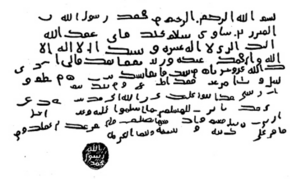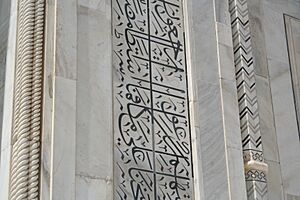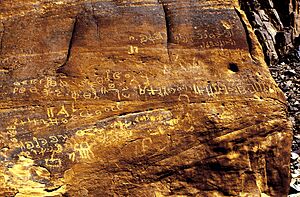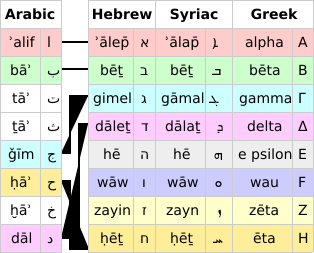History of the Arabic alphabet facts for kids
| This article contains special characters. Without the correct software, you may see question marks, boxes, or other symbols. |
The Arabic alphabet is a writing system that developed from older alphabets. It's believed to have come from the Nabataean alphabet, which itself came from the Aramaic alphabet. The Aramaic alphabet also led to the Hebrew alphabet and the Greek alphabet. The Greek alphabet then became the basis for the Latin and Cyrillic alphabets, which are used for many languages today, including English.
Contents
How the Arabic Alphabet Began
The Arabic alphabet most likely grew out of the Nabataean alphabet. Some people think it might have come directly from the Syriac alphabet, but this idea is not as widely accepted.
To understand how it changed, look at the table below. It shows how letter shapes evolved from the ancient Aramaic alphabet to Nabataean, Syriac, and finally, modern Arabic. Arabic is placed in the middle to help you see the changes clearly, not to show the exact order of time.
| Phoenician | Aramaic | Nabataean | Arabic | Syriac | Latin | |
|---|---|---|---|---|---|---|
| Image | Text | |||||
| 𐤀 | 𐡀 | ﺍ | ܐ | A | ||
| 𐤁 | 𐡁 | ٮ | ܒ | B | ||
| 𐤂 | 𐡂 | حـ | ܓ | C | ||
| 𐤃 | 𐡃 | د | ܕ | D | ||
| 𐤄 | 𐡄 | ه | ܗ | E | ||
| 𐤅 | 𐡅 | ﻭ | ܘ | F | ||
| 𐤆 | 𐡆 | ر | ܙ | Z | ||
| 𐤇 | 𐡇 | ح | ܚ | H | ||
| 𐤈 | 𐡈 | ط | ܛ | — | ||
| 𐤉 | 𐡉 | ى | ܝ | I | ||
| 𐤊 | 𐡊 | كـ | ܟ | K | ||
| 𐤋 | 𐡋 | لـ | ܠ | L | ||
| 𐤌 | 𐡌 | مـ | ܡ | M | ||
| 𐤍 | 𐡍 | ں | ܢ | N | ||
| 𐤎 | 𐡎 | — | ܣ | — | ||
| 𐤏 | 𐡏 | عـ | ܥ | O | ||
| 𐤐 | 𐡐 | ڡـ | ܦ | P | ||
| 𐤑 | 𐡑 | ص | ܨ | — | ||
| 𐤒 | 𐡒 | ٯ | ܩ | Q | ||
| 𐤓 | 𐡓 | ﺭ | ܪ | R | ||
| 𐤔 | 𐡔 | سـ | ܫ | S | ||
| 𐤕 | 𐡕 | ٮ | ܬ | T | ||
Historians believe the Nabataean alphabet changed into the Arabic alphabet in these ways:
- Around 600-500 BCE, Arab tribes moved north and created a kingdom near Petra, Jordan. These people, called Nabataeans, spoke a language similar to Arabic.
- By 200-100 BCE, the Nabataeans wrote in Aramaic, which was used for trade. Their writing system, a form of the Aramaic alphabet, started to change. It split into two styles: one for official inscriptions and a faster, more connected style for writing on papyrus. This faster style gradually turned into the Arabic alphabet we know today.
- Experts like Laïla Nehmé have shown that this change from Nabataean Aramaic to Arabic script happened between the 3rd and 5th centuries CE.
Early Arabic Writing Before Islam
The oldest known text written in the Arabic alphabet is the Zabad inscription, from 512 CE. It was found in Syria and is written in three languages: Greek, Syriac, and Arabic. The Arabic part of this inscription used only 21 letters, with only 15 distinct shapes, to represent 28 different sounds. This meant many letters looked the same!
Thousands of older Arabic inscriptions exist, but they use different alphabets. For example, Safaitic and Hismaic writings are from ancient North Arabian dialects. The earliest Arabic inscriptions using the Arabic alphabet are very rare, with only five known for sure. They often don't have dots, making them hard to read because many letters had the same basic shape.
Challenges with Early Arabic Letters
The Nabataean alphabet had 22 letters for 22 sounds. But the Arabic language has 28 different consonant sounds (called phonemes). This meant that when the Nabataean alphabet was used for Arabic, 6 of its letters had to represent two different sounds each. For example:
- The letter for d also stood for ð (like 'th' in 'this').
- The letter for ħ also stood for kh (like 'ch' in 'loch').
- The letter for ṭ also stood for ẓ.
- The letter for ʕ also stood for gh.
- The letter for ṣ also stood for ḍ.
- The letter for t also stood for θ (like 'th' in 'thin').
As the writing became more connected (cursive), some letters started to look exactly alike. This made it even harder to tell them apart.
In the image above, Arabic letters are shown in their modern forms. Letters with the same shape have colored backgrounds. For example, the letters for 'b', 'n', and 't' looked the same. The letter for 'y' also looked similar, especially at the beginning or middle of words. This meant that one letter shape could represent up to five different sounds! After all these changes, there were only 17 unique letter shapes for 28 sounds.
Changes in Early Islamic Times
The Arabic alphabet, in its more developed form, first appeared in the 600s CE. One of the earliest surviving examples of Islamic Arabic writing is from 643 CE.
When the Qur'an (the holy book of Islam) was being written down, scribes realized how difficult it was to read the text because so many letters looked alike. They needed a better system. Older alphabets like Nabataean and Syriac sometimes used dots to tell similar letters apart. Following this idea, dots were added to the Arabic alphabet. This created enough unique letters for all 28 sounds of Classical Arabic.

The first document that clearly uses these dots is a papyrus from April 643 CE. However, these dots didn't become a must-have until much later. Important texts like the Qur'an were often memorized by heart. This helped people understand the text even with the confusing script, especially since books were rare and copied by hand.
Later, signs for vowels and other sounds (like the hamza) were added. This started around the late 500s CE, similar to how vowel signs were developed in Syriac and Hebrew. At first, red dots were used: a dot above meant 'a', below meant 'i', and on the line meant 'u'. But this was confusing because it looked too much like the dots used to tell letters apart. So, about 100 years later, the modern system of vowel marks was created. This system was finalized around 786 CE by a scholar named al-Farahidi.
Organizing the Arabic Alphabet
About a century after Islam began, Arab scholars reorganized the alphabet. They grouped letters that looked similar together, which made it easier to teach. This new order was different from the older "numeric order" (where letters also stood for numbers). The numeric order became less important as Indian numerals (the numbers we use today) became more common.
The older alphabetical order, also seen in Hebrew, Syriac, and Greek alphabets, is called the Levantine or Abjadi order. If you arrange the letters by their traditional numeric value, you get this older order back:
| Arabic | Hebrew | Syriac | Greek | Value | ||||
|---|---|---|---|---|---|---|---|---|
| ʾalif | ا | ʾālep̄ | א | ʾālap̄ | ܐ | alpha | Α | 1 |
| bāʾ | ب | bēṯ | ב | bēṯ | ܒ | bēta | Β | 2 |
| ǧīm | ج | gimel | ג | gāmal | ܓ | gamma | Γ | 3 |
| dāl | د | dāleṯ | ד | dālaṯ | ܕ | delta | Δ | 4 |
| hāʾ | ه | hē | ה | hē | ܗ | epsilon | Ε | 5 |
| wāw | و | wāw | ו | wāw | ܘ | wau | Ϝ | 6 |
| zāy | ز | zayin | ז | zayn | ܙ | zēta | Ζ | 7 |
| ḥāʾ | ح | ḥēṯ | ח | ḥēṯ | ܚ | ēta | Η | 8 |
This older order is much more ancient. The earliest Arabic writings show why the order was changed later on.
Arabic Script Spreads and Changes

The Arabic script became very beautiful and spread widely during the Abbasid Caliphate (a powerful Islamic empire). During this time, scholars like Ibn al-Bawwab and Ibn Muqla helped standardize Arabic writing. They developed "proportioned script," which meant letters were written with specific, balanced measurements.
When the Arabic alphabet spread to countries that spoke other languages, new letters had to be invented to write sounds that didn't exist in Arabic. Often, this was done by adding three dots above or below an existing Arabic letter.
For example:
- In Urdu, special marks were added to letters to represent "retroflex" sounds (sounds made by curling the tongue back).
- In some languages, new letters like چ (for 'ch' sound) or پ (for 'p' sound) were created.
Decline in Use by Some Countries
Since the early 1900s, after the Ottoman Empire fell and European influence grew, many non-Arab countries that used the Arabic alphabet started switching to the Cyrillic or Latin alphabet.
| Area used | Arabic spelling system | New spelling system | Date | Ordered by |
|---|---|---|---|---|
| Some countries in the Soviet Union, especially Muslim States | Persian-based spelling system, later Ottoman Turkish alphabet with changes | Cyrillic | 1920s (to Janalif) 1930s (to Cyrillic) |
USSR government |
| Bosnia and Herzegovina | Ottoman Turkish alphabet | Gaj's Latin alphabet | 1870s-1918 | |
| Brunei Indonesia Malaysia Philippines (Mindanao) Thailand (Pattani) |
Jawi (still widely used in Brunei and Patani) and Pegon script | Latin alphabet and Thai script | 19th century | European (British, Dutch and Spanish) colonial administrations |
| Turkey | Ottoman Turkish alphabet | Turkish alphabet (Latin system with changes) | 1928 | Republic of Turkey government after the fall of the Ottoman Empire |
In many cases, using the Arabic script for these languages is now mostly for old texts or traditional purposes. In other places, like Brunei with its Jawi writing, the Arabic alphabet is still used alongside the Latin alphabet.
See also
Images for kids















































